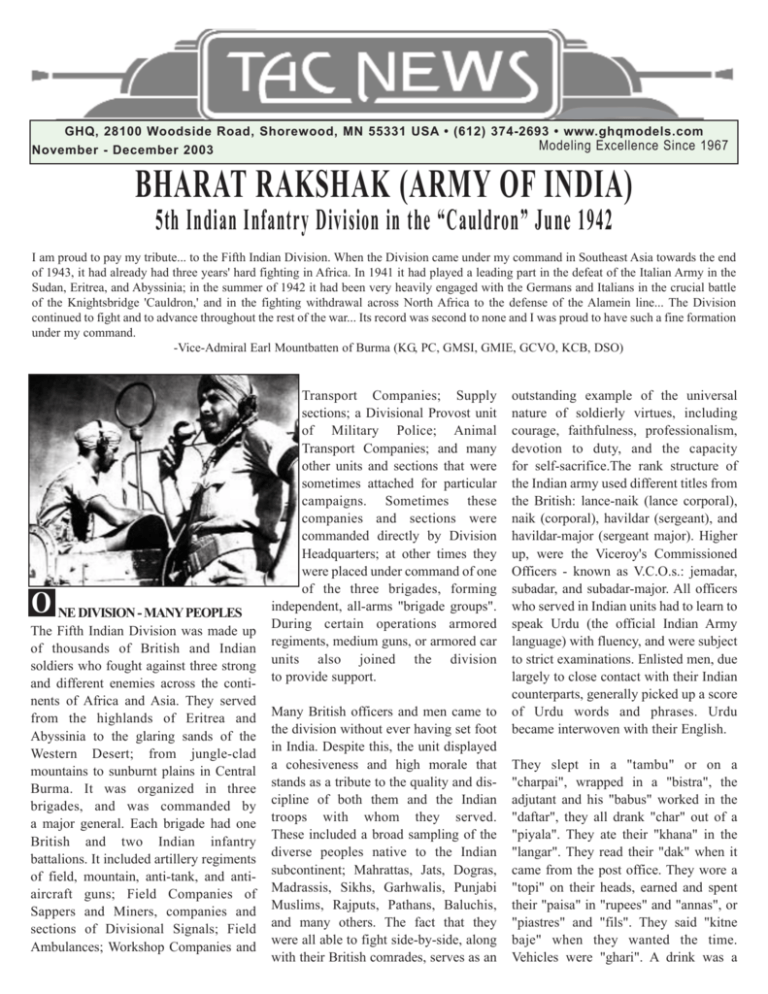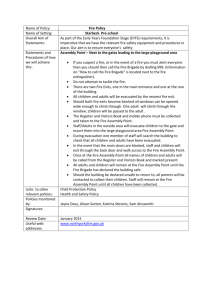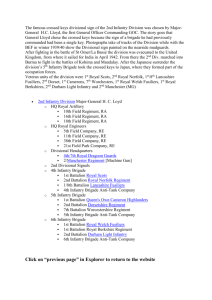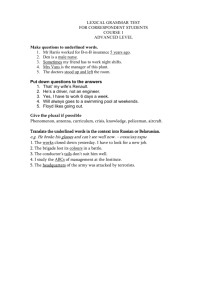Bharat Rakshak, '42 Army of India Pt.1
advertisement

GHQ, 28100 Woodside Road, Shorewood, MN 55331 USA • (612) 374-2693 • www.ghqmodels.com Modeling Excellence Since 1967 November - December 2003 BHARAT RAKSHAK (ARMY OF INDIA) 5th Indian Infantry Division in the “Cauldron” June 1942 I am proud to pay my tribute... to the Fifth Indian Division. When the Division came under my command in Southeast Asia towards the end of 1943, it had already had three years' hard fighting in Africa. In 1941 it had played a leading part in the defeat of the Italian Army in the Sudan, Eritrea, and Abyssinia; in the summer of 1942 it had been very heavily engaged with the Germans and Italians in the crucial battle of the Knightsbridge 'Cauldron,' and in the fighting withdrawal across North Africa to the defense of the Alamein line... The Division continued to fight and to advance throughout the rest of the war... Its record was second to none and I was proud to have such a fine formation under my command. -Vice-Admiral Earl Mountbatten of Burma (KG, PC, GMSI, GMIE, GCVO, KCB, DSO) O NE DIVISION - MANYPEOPLES The Fifth Indian Division was made up of thousands of British and Indian soldiers who fought against three strong and different enemies across the continents of Africa and Asia. They served from the highlands of Eritrea and Abyssinia to the glaring sands of the Western Desert; from jungle-clad mountains to sunburnt plains in Central Burma. It was organized in three brigades, and was commanded by a major general. Each brigade had one British and two Indian infantry battalions. It included artillery regiments of field, mountain, anti-tank, and antiaircraft guns; Field Companies of Sappers and Miners, companies and sections of Divisional Signals; Field Ambulances; Workshop Companies and Transport Companies; Supply sections; a Divisional Provost unit of Military Police; Animal Transport Companies; and many other units and sections that were sometimes attached for particular campaigns. Sometimes these companies and sections were commanded directly by Division Headquarters; at other times they were placed under command of one of the three brigades, forming independent, all-arms "brigade groups". During certain operations armored regiments, medium guns, or armored car units also joined the division to provide support. Many British officers and men came to the division without ever having set foot in India. Despite this, the unit displayed a cohesiveness and high morale that stands as a tribute to the quality and discipline of both them and the Indian troops with whom they served. These included a broad sampling of the diverse peoples native to the Indian subcontinent; Mahrattas, Jats, Dogras, Madrassis, Sikhs, Garhwalis, Punjabi Muslims, Rajputs, Pathans, Baluchis, and many others. The fact that they were all able to fight side-by-side, along with their British comrades, serves as an outstanding example of the universal nature of soldierly virtues, including courage, faithfulness, professionalism, devotion to duty, and the capacity for self-sacrifice.The rank structure of the Indian army used different titles from the British: lance-naik (lance corporal), naik (corporal), havildar (sergeant), and havildar-major (sergeant major). Higher up, were the Viceroy's Commissioned Officers - known as V.C.O.s.: jemadar, subadar, and subadar-major. All officers who served in Indian units had to learn to speak Urdu (the official Indian Army language) with fluency, and were subject to strict examinations. Enlisted men, due largely to close contact with their Indian counterparts, generally picked up a score of Urdu words and phrases. Urdu became interwoven with their English. They slept in a "tambu" or on a "charpai", wrapped in a "bistra", the adjutant and his "babus" worked in the "daftar", they all drank "char" out of a "piyala". They ate their "khana" in the "langar". They read their "dak" when it came from the post office. They wore a "topi" on their heads, earned and spent their "paisa" in "rupees" and "annas", or "piastres" and "fils". They said "kitne baje" when they wanted the time. Vehicles were "ghari". A drink was a "tanda pani". Bread was "roti". When darkness fell they lit a "batti" in their tents. A British soldier riding beside an Indian driver might shout out "roco"! When he wanted to stop, "ahista" (pronounced arsti) to slow down, and "jao" or "jaldi" to speed up. An order was a "hukm", any swap was a "badali", and the war was the "larai". The Italians, Germans, and Japanese were the "dushman". Understanding or approval alternated between 'O.K.' and "Tikh hai", while praise was expressed by a shout of "shahbash"! ORIGINS The Fifth Indian Division was formed in the Deccan District, composed of the 7th Poona Brigade, the 9th Secunderabad Brigade, and the 10th Jhansi Brigade. Training the new division was difficult due to a lack of modern equipment. When complaints were lodged, the staff was informed that the Cabinet had decided the Indian Army would not take part in major combat at all. In consequence, all the new equipment was being sent to the British Army in France. The first Divisional Commander was Major-General L. M. Heath, C.B., C.I.E., D.S.O., M.C., a wounded veteran of WWI, and the Northwest Frontier. Heath was a man of ability and energy and established a solid foundation upon which his division built a proud combat record from the Sudan to Java over the nextfour years. Heath invariably wished to observe his men in action atfirst hand. He therefore spent a lot of time in the air. He was a good flyer, though a damaged arm prevented his being given a license. Whenever possible he made an aerial reconnaissance of the ground before battle was engaged. As a commander, he refused to be hurried, never seemed depressed, and timed his attacks and maneuvers with skill. Among friends, he was called "Mac" or "Piggy." "BALL OF FIRE" The origin of the Fifth Indian Division "patch" is a bit uncertain. The G.S.O.1 of the Division, Colonel Frank Messervy, submitted a design that included a boar's head, so it would be linked with the nickname of its first commander. But vehement objections to this idea were raised on the grounds that such an insignia would arouse resentment among Muslim troops. He then tried the heads of other animals, but each had already been selected by some other formation. In the end, a plain red circle was chosen. It was simple and distinctive. General Heath approved. The red circle on a black background gradually came to symbolize a "Ball of Fire". REORGANIZATIONS In the Sudan, various changes were made. 29 Brigade, composed of three British battalions, was split up. The 1st Worcestershires remained. The 2nd West Yorkshires went to Mayne's Nine Brigade, while the 1st Essex joined Ten Brigade. This way, each of the three brigades now had one British and two Indian battalions. Brigadier Marriott commanding the newly constituted 29 Brigade, had the 3/2nd Punjab and 6/13th Frontier Force Rifles. 9 Brigade had the 3/5th Mahratta Light Infantry and 3/12th Frontier Force Regiment. Brigadier Slim's 10 Brigade had the 4/10th Baluch and 3/18th Royal Garhwal Rifles. The division gained valuable combat experience in the Sudan. In addition the unit quickly became acclimated to the demands of desert warfare including celestial navigation, night maneuvers, camouflage, all-around defense, and a reliance on individual initiative, all of which came from campaigning over vast areas of poorly mapped wilderness. While the division underwent rest and refit in Cyprus, the 3/5th Mahratta Light Infantry, the 6/13th Royal Frontier Force Rifles, and the 3/18th Royal Garhwal Rifles were posted elsewhere. To replace the Mahrattas, 9 Brigade got the 3/9th Jats, commanded by Lt. Colonel H. V. Bragg. At the beginning of May, they were joined by the 1/5th Mahratta Light Infantry. Brigadier Boucher's command got the first Gurkha battalion to serve with the Division, the 2/4th Gurkha Rifles. After transferring to Africa, the current Division Commander, who had led Nine Brigade in the Sudan and Eritrea, MajorGeneral Mayne, was promoted to command a Corps in Iraq. By mid-May, Major-General H. R. Briggs, known to the officers, and no doubt to the men, as "Briggo", took command. Briggs had earned a reputation as a "fighting" soldier in East Africa and the Western Desert, leading the breakout from Benghazi earlier that year. In action he could be fierce and quick-tempered, but he was neither petty nor vindictive. He was imperturbable, a good leader in a tight corner, and never allowed himself to become rattled. THE WESTERN DESERT: APRIL - MAY 1942 10 Brigade, now commanded by Brigadier Charles H. Boucher, arrived in Haifa on 12 March. Trains bore them south and on 8 April, the brigade set off for the Western Desert, and moved through Amariya and Mersa Matruh to Halfaya Pass. Meanwhile Fletcher's 9 Brigade embarked early in the month from Cyprus and sailed direct to Alexandria. On 15 April, Division Headquarters and 9 Brigade moved to the Sollum "box" (fortified base camp) and, in company with other divisions in the Middle East, reorganized on a "Brigade Group" basis. This meant that artillery regiments, field companies of engineers; field ambulances and other service units and detachments were placed under direct command of a brigade expected to act as independent formations. Reid's 29 Brigade, already at El Hamra, rejoined the Division after a long period away with the Eighth Army. 9 and 10 Brigades concentrated first on the flat, stony ground near Sollum. Then, on the 25th, they linked up with Reid's force at the "Kennels" box by El Hamra. Throughout this period, heavy dust storms blew up, and men learned to endure days on end of the "khamseen" with stinging grit. The heat was often fierce, and many suffered from heatstroke. Particular attention was paid to desert navigation, the use of sun compasses, and the establishment of brigade group "boxes", known colloquially as "cowpats." The battalions practiced moving in desert formation and trained in minelaying. Senior officers liaised with their opposite numbers in the brigades, particularly Reid's 29 Brigade, which had already been in the Sahara for quite some time. THE 1942 GERMAN OFFENSIVE On January 21, the Axis began a new offensive. Rommel actually planned this to be merely a "raid", but it soon outpaced British forces in Cyrenaica, driving them back from Agedabia to Msus. A stand was ordered at Benghazi, but a feint by the Germans left the 4th Indian Division isolated in the town. Briggs, in command of 7 Brigade, was instrumental in the ensuing breakout. On 4 February, the force reached the defense line at Gazala, which the remainder of Ritchie's Eighth Army was busy fortifying in preparation for a coun- terattack. Things remained calm between February and May, as both sides raced tobuild up strength. A major Axis air offensive against Malta made a steady reinforcement and resupply of German and Italian forces in Libya possible. It soon became clear to allied commanders that they had lost the reinforcement race. The Germans and Italians would strike first. GAZALA By 15 May, large numbers of enemy vehicles were deployed in forward areas. Air reconnaissance showed the 15th and 21st Panzer Divisions ready to attack. During the whole month of March the enemy had unloaded only 1,500 tons of supplies at Benghazi. He was now unloading 2,000 tons a day! Eighth Army planned to give the impression that their forces were unprepared, but actually deployed their armored formations to first blunt the enemy's initial thrust, then contain his tanks in the area between the Gazala line and Knightsbridge. It was essential both that the enemy's main attack should come from the south and that the Gazala defenses hold. On 25 May, the Tobruk defense perimeter was divided between the 2nd South African Division and Fletcher's 9 Brigade. Fifth Indian Division Headquarters and 10 Brigade, in reserve, had the task of guarding the group of airfields north and south of the Trigh Capuzzo near Gambut, and of protecting Advanced Army Headquarters there. 29 Brigade was at Bir el Gubi. General Auchinleck felt that the Eighth Army had sufficient infantry to cope with any eventuality and a numerical superiority in tanks, but there was no reserve of field artillery. Auchinleck believed that, whether the German and Italian forces tried to break his center by attacking on a narrow front, or tried to pass south of Bir Hakeim, their object would be the capture of Tobruk. Therefore, he intended to force them to depend on the long and exposed southern route for supplies and defeat them in the triangle formed by Gazala, Tobruk, and Bir Hakeim. To accomplish this, they had to be stopped short of Tobruk, then attacked in the flank with armor, in the rear with infantry and guns, and dealt a blow from which they could not recover. The 5th Division's actual role was supposed to be as advance guard for the eventual British counterattack. Its actual role was to be quite different. Panzerarmee Afrika attacked by moonlight on May 27. Its main thrust curved round the southern flank of the "Gazala Line" and came up against the 3rd Indian Motor Brigade southeast of Bir Hakeim. They fought with tenacity, but were overwhelmed. By midday on the 28th, Axis forces were engaged from Knightsbridge thirty miles east to Bell Hammed, along the Dud ridge. That evening the main German strikeforce was stretched out over a vast expanse of desert. Dust clouds from numerous softskinned supply vehicles could be seen for many miles, an ideal target for the RAF. One group of Germans moved against Acroma, but soon withdrew. British armor began to gain the upper hand, and the Panzers found themselves held up along a line between Knightsbridge and El Adem and pinned against the Gazala line in the area known later as the "Cauldron." Heavy fighting went on all day. By nightfall, the situation was still in doubt. Rommel then drew back his armor, occupying an area right in the middle of the British minefields north of Bir Hakeim. He was surrounded and believed trapped. On the west were the dense minefields linking Gazala and Bir Harmat. On the east were British and Commonwealth troops dug in from Bir Harmat through Knightsbridge to the coast. To the north were the South Africans, the 50th Northumbrian Division, deployed among more groups of minefields, and the sea. Far too great a reliance was placed on these minefields. They were to prove less than invincible. Rommel soon turned them to his own advantage and protection. On 31 May, under cover of a violent dust storm, German engineers cut two lines through the minefields to the east, ten miles apart, on both sides of 150 Brigade's position at Sidi Muftah. This bridgehead provided a new supply route to his forces in the Cauldron to replenish diminishing supplies of food, water, ammunition, and petrol. 150 Brigade was now isolated! Furious but uncoordinated British counterattacks failed to relieve them. They were overrun on 1 June. Rommel widened his bridgeheads. Supplies continued to pour into the "Cauldron". Allied optimism faded. The German supply corridors simply had to be closed! Reid's 29 Brigade had meantime moved from El Gubi to El Adem, and was under command of 13 Corps. Marriot's 201st Guards' Brigade held Knightsbridge. Nine Brigade under Fletcher had driven down from Tobruk to the same area. Boucher's 10 Brigade was in the neighborhood of Bir Harmat. It was planned to form two "boxes" opposite the corridors, a northern one at Bir et Tamar held by 10 Brigade, a southern box two miles west of Bir el Harmat by Fletcher's 9 Brigade. Delays occurred. Days passed while Rommel reinforced and refueled the unitsin the Cauldron. It was four days before Eighth Army attacked in force. By then, it was too late. By this time the Germans had brought in a number of 88mm FlaK guns to stiffen their defense. The situation was now reversed. The Germans were dug in and Eighth Army was forced to attack on a narrow front or abandon their carefully planned positions. Rommel had been able to disengage one armored division, rest and re-equip it, and bring it up ready for an assault on Tobruk. It began to move at precisely the same time as the 5th Indian Division began to attack the 'bulge' in the Cauldron. IN THE NEXT ISSUEThe conclusion of “Bharat Rakshak” and Micro Armour Scenario #14 “Thornburn’s Last Stand”! 5TH INDIAN INFANTRY DIVISION North Africa: June, 1942 Infantry Company: Support Company: Machinegun Company: Engineer Squadron: Anti-Tank Battery: Artillery Battery: Anti-Aircraft Battery: Machinegun Company: 3 x Infantry, 3 x Truck 1 x 3" Mortar(2), 1 x Engineer, 1 x Infantry/Bren Carrier[R] 3 x Infantry Support 3 x Engineer 4 x 2lbr ATG/Truck 2 x 25lbr(2)/Truck 3 x 40mm "Bofors"/Truck 3 x Infantry Support/Truck Infantry Battalion: Artillery Regiment: 1 x Infantry "HQ", 4 x Infantry Company, 1 x Support Company 3 x Artillery Battery, 1 x Anti-Tank Battery Infantry Brigade Group: 1 x Infantry "GHQ", 3 x Infantry Battalion, 1 x Artillery Regiment, 1 x Engineer Squad, & 1 x Anti-Aircraft Battery Division: 3 x Brigade Group, 1-3 x Machinegun Company Notes: 1) The division TO&E mentions no MG companies. However, several references do appear in the official 5th Division history. 2) Sufficient truck transport was available to motorize any unit in the division. 3) 5th Indian Infantry Division was made up of the following units in June, 1942: 9 Brigade - Brigadier Fletcher 2nd Bn / West Yorkshire Regiment 3rd Bn / 12th Frontier Force Regiment 3rd Bn / 9th Jat Regiment 10 Brigade - Brigadier Boucher 2nd Bn / Highland Light Infantry 2nd Bn / 4th Ghurka Rifles 4th Bn / 10th Baluch Regiment 29 Brigade - Brigadier Reid 1st Bn / Worcestershire Regiment 3rd Bn / 2nd Punjabi Regiment 1st Bn / 5th Mahratta Light Infantry Regiment Also: 3rd, 4th, & 18th Field Regiments / Royal Artillery and 25th Light Anti-Aircraft Regiment / Royal Artillery




